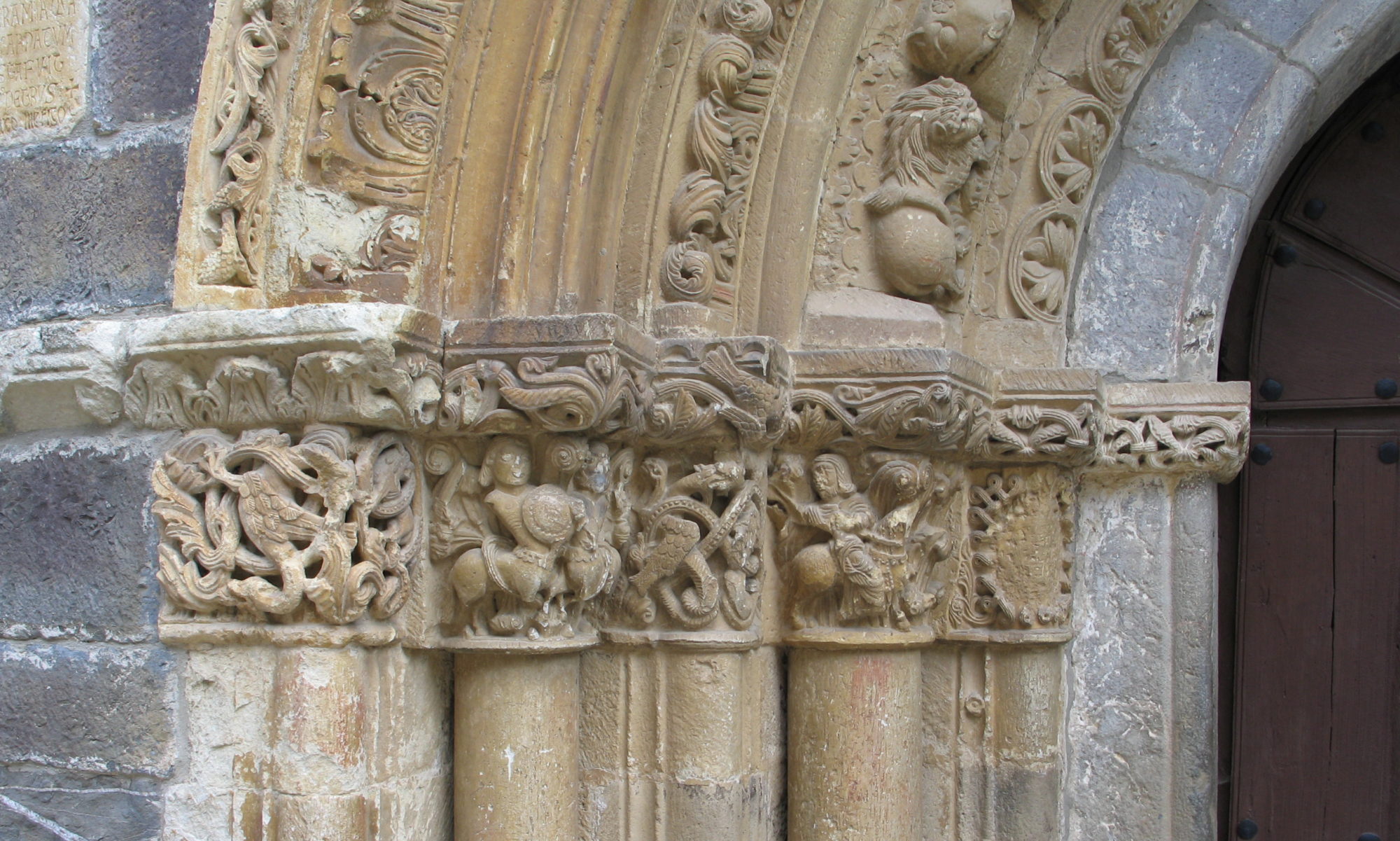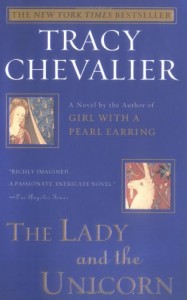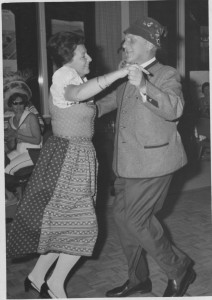She’d earn her place on this earth for her contributions to the history and culture of medieval Spain alone, but Cynthia Robinson is also an author of compelling and engaging contemporary literary fiction. I read the first few chapters of this in draft, and I am really glad to see it has been published. So check out Tatiana’s Wedding if you are looking for a good read. Lovely cover too:

Kim Silveira Wolterbeck, A Place of Light
 Robert of Arbrissel is one of the most fascinating characters from the Middle Ages. A truly counter-cultural figure, he was a monk and a hermit who preached poverty and renunciation of the world, and surrounded himself with the rejected and outcast of medieval society: lepers, the poor, and women, including prostitutes.
Robert of Arbrissel is one of the most fascinating characters from the Middle Ages. A truly counter-cultural figure, he was a monk and a hermit who preached poverty and renunciation of the world, and surrounded himself with the rejected and outcast of medieval society: lepers, the poor, and women, including prostitutes.
A Place of Light builds off one of the most compelling stories told about him by his contemporary, Baldric of Dol. According to Baldric, one day Robert walked into a brothel in Rouen, and preached about sin to the women inside. They, swayed by his words and moved by his vision for their future, followed him into the wilderness on his path to found a new community where they could live in peace and safety. In her novel about Robert and how he founded the medieval abbey of Fontevrauld (known best of all now as the site of Eleanor of Aquitaine’s vivid tomb) with these women, Wolterbeck asks who they might have been, what their stories were, and why they followed Robert. It is a richly imagined and gripping portrait that treats religious ideals and idealism alongside vanity, pride, envy, greed, and lust with authenticity and nuance. If you are tired of historical novels that promise “meticulous research,” then deliver cardboard characters out of step with their age (medievalist friends, I have you especially in mind), you will love this book as I did. Wolterbeck never takes the easy or obvious route with any of her main characters (who include, in addition to Robert the monk, Madeleine, the wary prostitute; Philippa, the mis-married duchess of Aquitaine; and Girard, the failed Benedictine). The unsympathetic characters have virtue and potential; the characters we love the most have flaws and hidden damage. Indeed, if there is a theme to this book, it is the relationship between damage and redemption. Its message is one the medieval audiences of Robert’s sermons would have understood: we all are sinners; we all can be saved.
I was especially excited/nervous/anxious to read this book, because it is the first published offering from Cuidono Press, the press that will be publishing my own novel, Pilgrimage and in the interest of full disclosure, the novel was a gift to me from its editor. But if you have been reading my reviews over the years, you know that I do no reviews by request, and that I only review books that I love. This is especially important to me for books about the Middle Ages. I am proud my book will be standing beside this one.
Passover
We celebrated Passover tonight; me, my son, and my husband. It is something I’ve done more years than not since my son was at pre-school at Akiba-Schechter, sometimes with friends, but most often just me and him, and now, this year, my husband too. It seemed a natural thing to do when my son was bringing home paper seder plates with the sections marked, a children’s haggadah with frogs pasted in haphazardly, and a tie-dyed matzah cover.
Every year it means something a little bit different. This year, I think of my cousin and uncle, celebrating in Israel on their first visit there, with the Berman family, with whom ours has been bound for so many decades. My son and I shared part of this season with them three years ago. I think of my grandfather, the first of our family to find himself in Jerusalem, who left from there for England on April 2, 1939 missing the start of Passover by only a couple of days. My grandmother probably rarely celebrated, if at all, but I am sure that until he was forced to flee his homeland at least, my grandfather celebrated every year. Did he celebrate with his fellow Czech refugees in their messy flat in Putney in 1939? Or was that the first year he let it slip? And this year the words of the Haggadah expressing the joy of the Jews at their liberation, and their gratitude to the God who protected and saved them ring especially loud. “He brought us out from slavery to freedom, from sorrow to festivity, from darkness to great light.” I imagine my ancestors repeating this over the centuries during times when they were far from free or festive. But each year they repeated these words of joy and humility and gratitude no matter their current pain.
A couple of weeks ago, my husband and I drove out of town one Saturday to visit an old friend who is dying. Strangely enough, we both knew her through completely different channels long before we met each other. We were not surprised that she was only capable of speaking to us for a very few minutes. She was in her beautiful bedroom, in a hospital bed facing a large window looking onto the sky and the trees, agonizingly slow to come into bud this year.
“You have a beautiful view,” I said.
“I know,” she replied, before she drifted back to sleep. “I’m lucky.”
Whence Inspiration?
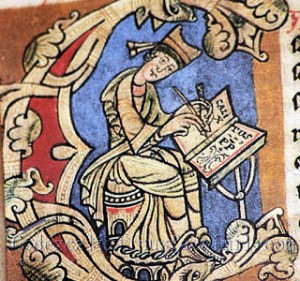 Every book is the product of a kajillion (give or take a gazillion) little twinkles of inspiration, intuition, or insight, but those key lightbulb-above-the-head moments, when you look up from whatever you were doing and know you have a story to tell are much more precious and rare.
Every book is the product of a kajillion (give or take a gazillion) little twinkles of inspiration, intuition, or insight, but those key lightbulb-above-the-head moments, when you look up from whatever you were doing and know you have a story to tell are much more precious and rare.
PILGRIMAGE was the produce of two questions that combined into one lightbulb moment in the year or so after my son was born, when I was on a postdoctoral fellowship. This was back in ancient times, before the World Wide Web, Facebook, and Google. I used to spend my spare time connecting with other medievalists on those newfangled specialist listservs. One of my favourites had a “saint of the day” feature with a little biography, and one July 6th, the story was all about Saint Godeleva, patron of battered wives, whose Flemish husband had her murdered at the end of the eleventh century. The biography also recounted a late legend about Godeleva — that her husband had gone off on crusade to expiate his crime, and that he also had a daughter who was blind. What would it feel like, I wondered, to have a saint for a mother, who cured everyone except for you? That was my first question.
The second came from a manuscript, the Codex Calixtinus, to be precise. You can see an initial from the manuscript, showing Pope Calixtus II purportedly writing a section of the manuscript, at the top of this post. This manuscript contains a colophon, that describes the origin of the manuscript in an unusual way. It reads:
The Poitevin Aimery Picaud of Partheney-le-Vieux and Oliver d’Asquins and their friend Gebirga of Flanders gave this book to Saint James of Galicia for the redemption of their souls.
Now, figuring out the authorship of this volume is highly complicated because those who actually wrote the texts in it took care to attribute them to more important people, like Pope Calixtus, above. Our best guess is that it had several authors, and Aimery Picaud, whoever he was, was its compiler. Who then was Gebirga of Flanders, and how did an unknown woman become important enough to have her name mentioned in this work with its lofty pretensions?
That was my second question. And then, the light went on — Gebirga of Flanders became the blind daughter of Saint Godeleva, and I knew I had a story.
PILGRIMAGE — Some news and a description
As I wrote last October, my first novel, Pilgrimage, is going to be published by Cuidono Press, a new small press based in Brooklyn (I think those of you who enjoy the Middle Ages might be interested in its first released book, A Place of Light, on the origins of the Abbey of Fontevraud.) I am delighted to let you all know that my novel will be released this June.
And I think it is finally time for me to let you know what it is about. People who write talk about “conference pitches,” “elevator pitches,” etc. This is my current “dust-jacket pitch”:
For the rest of twelfth-century Europe, Spain was a far-off and exotic place, rich in silks, ivory, and gold, full of Muslims and Jews, and raging with battles between rival kings and kingdoms. It was also home to the mystical Christian holy site of Compostela at the western edge of the known world, shrine of Saint James. The saint’s tomb drew a perpetual wave of pilgrims, coming for adventure, seeking a miracle from the saint, or performing penance to expiate an old sin.
PILGRIMAGE is the story of one of those pilgrims. Gebirga of Flanders, the blind, dispossessed daughter of martyred Saint Godleva. She flees her callous family with a pack of pilgrims that includes a count’s daughter, bound for marriage, and a mysterious messenger with an unknown agenda, all bound for Compostela. The journey takes Gebirga from her home on the edge of the North Sea across the kingdoms of France and into the Iberian Peninsula, where she is caught up the swirling winds of political change, from restless, power-hungry kings and queens, to the Roman Pope. Beneath all the birthing of nations, churches, and ideas, PILGRIMAGE is a story of a young woman struggling with her station in life and trying to find her place in the world.
And speaking of dust-jackets, we are still working on the cover, but in the meantime, I want to point you in two directions. The first is to look up at the image in the header of this blog, shot by me in Spain at a place where one of the major scenes in the novel takes place. I discussed this place in my very first blog post, The Image in my Header. Next, look down. This is a painting I bought at the Hyde Park Art Fair several years ago because it reminded me of Gebirga’s journey from Flanders to Spain. I like to think those are the Pyrenees in the distance.
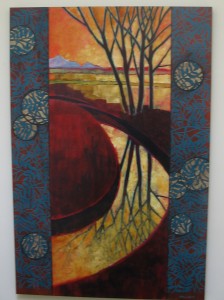
Tracy Chevalier, The Lady and the Unicorn
I am that strange person who did not like The Girl with the Pearl Earring, but loves the rest of Tracy Chevalier’s work. This goes true for her The Lady and the Unicorn, which I just finished tonight. To be honest, I started it tonight too. A story of the creation of the famous Unicorn tapestries, now housed at the Musee de Cluny, in Paris, it is that good.
If you read other reviews of this book, you will find that their authors can’t resist the chance to use “tapestry” metaphors when describing Chevalier’s skill. “A deftly woven tapestry,” “not a stitch is missing,” they write. However, this attention to the book as the fully-realized production of a single person, an “author,” seems to miss the exact point Chevalier is trying to make about artistic creation. Nicholas des Innocents, the painter who designed the tapestries, is at the heart of her book, and it is he whom a modern audience would credit with being their “author.” But the story is designed to show us how these wonderful examples of the fifteenth-century art of weaving are in fact the product of many, many hands and brains and sources of inspiration. Chevalier reveals to us, not only the contribution of the designer and the members of Brussels atelier that weaves the tapestries, but the the role of the patrons who debate over the design; the merchant who acts as go-between, hiring the designer and arranging for his work to be made a reality; the women who serve as muses; the servants who care for the house so the work can be done; the English wool workers who ship their cloth to Ostend; and even the unappealing Jacques Le Boeuf, smelly because of the urine used to fix the woad that gives the beautiful blues to the tapestries.
It is easy to suppose that Chevalier sees her own creation as an author in the same light. The fantasy is of an author who toils alone and creates a book as a pure, solitary act, the work of her brain transmitted through her hands onto the page. The reality is that Chevalier’s book had as many hands in it as the tapestries themselves: an agent and an editor and maybe other readers who suggested revisions and made comments at an early stage (Chevalier thanks a long list of people in her acknowledgements), and closer to publication, there was a copyeditor and proofreader. Someone designed the cover (actually, his name is Richard Hasselberger — it is on the back flap of the dust jacket — and it is a very nice cover indeed) and took the author photo (Jerry Brauer) and created the layout and chose the type face and given that this novel followed the huge success of Girl with the Pearl Earring there was probably a substantial group in charge of publicity and promotion. And we can add to this list the booksellers who hand-sold it, the librarians who recommended it, and all the people who reviewed it. All of these were needed to make The Lady and the Unicorn what it is. And none of this takes away from Chevalier’s work.
My Grandparents
Edgar J. Goodspeed, The Curse in the Colophon
 So many friends greeted my acquisition of this book with so much excitement that I thought a review was in order now I have finished reading it. For those that you don’t know, Edgar Goodspeed was a Theologian and New Testament scholar at my very own Divinity School at the University of Chicago, getting his degree from there in 1898 and teaching there between 1900 and 1937. Goodspeed was responsible for building up the manuscript collection that now bears his name at the university, a collection of New Testament manuscripts and papyri. How could I resist a book by another novel-writing colleague?
So many friends greeted my acquisition of this book with so much excitement that I thought a review was in order now I have finished reading it. For those that you don’t know, Edgar Goodspeed was a Theologian and New Testament scholar at my very own Divinity School at the University of Chicago, getting his degree from there in 1898 and teaching there between 1900 and 1937. Goodspeed was responsible for building up the manuscript collection that now bears his name at the university, a collection of New Testament manuscripts and papyri. How could I resist a book by another novel-writing colleague?
Especially a book devoted to the hunt for medieval manuscripts, a hunt that bears striking similarities to his own real-life acquisitions. For while he was a New Testament scholars, the materia for the study of the Greek New Testament is manuscripts copied in the Middle Ages. In his story, the first-person hero and narrator of the tale is assisted by the as-intelligent-as-she-is-beautiful Letitia (“Tish”) in a hunt for a cache of manuscripts hidden, after the fall of Constantinople, revealed by a curse found in the colophon of a manuscript being studied at the University of Chicago. It is a a sea-borne quest in which the scholars are assisted by wealthy American patrons to reach the monastery of Selime where they find the treasure they seek behind a trapdoor in a tomb: Byzantine regalia, and relics, and, best of all, illustrated manuscripts.
Shades of Indiana Jones. Only, not really. For while Goodspeed knows he has to add a few dastardly ruffians and menacing Greeks to his tale, he isn’t as comfortable with tales of high adventure as he is writing about the mundane frustrations and excitements of ordinary manuscript study. And that is the best thing about this book, from the perspective of this medievalist. We learn the virtues of using ultra-violet light over reagents to uncover text written in palimpsest, that is to say, text that has been over-written by another text. It is under the original cursed colophon that they find their clue to the location of the manuscripts they seek. They are thwarted by the demons that plague all of us: libraries with inconvenient opening times and backward equipment, jealous librarians who refuse to understand the crucial importance of our own personal quests, languages that need to be learned, transportation that must be acquired, and the religious agendas of those who are the custodians of the treasures the scholars seek to reveal. The final crisis comes, not at the hands of the enemies who have been dogging their every step (book dealers who *gasp* cut up manuscripts in order to sell their miniatures one by one), but at the hands of the customs officials who threaten not to let them remove their prizes from the country.
If you ever have had to sweet-talk someone in a language you don’t know very well to look at a manuscript you are sure will be crucial for your work, this is the novel for you.
When I Knew
The title is misleading. The question I still ask myself is not, “When did I know I was Jewish?” but, “How, in God’s name, did I not figure it out sooner?” I blame Captain von Trapp.
I cannot remember a time when I did not know the story of how my grandmother fled Czechoslovakia, weeks after the Germans invaded, with my two-year-old father in tow, to meet my grandfather in London (the story of how he got to London, however, remained a secret until much more recently). She was a great storyteller, and in her version, she was not a bold heroine, but a foolish and somewhat spoiled girl, slightly oblivious of the danger around her. I heard many times about how she charmed the Gestapo at the border into letting them leave, how they had to stay in Versailles, and how my grandmother abandoned my father every morning to the tender ministrations of “la promeneuse” so she could hot-foot it to Paris, and later, of their life in London and Wales, of ration cards, and air raids, and shoes that unaccountably did not get polished when you left them outside your door at night. What I did not hear anywhere attached to the story was the word, “Jew.” It was a word I never heard used by any member of my family, in any context.
And that is where the Sound of Music comes in. I saw it for the first time a long time ago, long enough ago that I remember standing for the national anthem before it began. My grandparents had come to visit in Toronto, and we all went together. And there, on the screen, was their story, their love for their homeland, the evil Nazis, and their flight to freedom. They even lived high on a hill with a lonely goatherd, in a Swiss Chalet. In Quebec. Here it is:
When the Captain sang “Edelweiss,” my mother says, tears rolled down my grandfather’s cheeks. Bless my homeland forever.
And once again, not a mention of the word “Jew” in the whole movie (Weirdly, when you think about it. Sure, the von Trapps weren’t Jewish. But Max? Max?). No wonder I was confused as the evidence began mounting and the questions started to come. Because I knew, I knew. But I didn’t know. I read When Hitler Stole Pink Rabbit and then all the Leon Uris books. I had dreams about being chased by Nazis. I even wrote a short story for school about a young girl, oh roughly my age at the time, escaping. I asked my father where our name came from. He lied (Miners from Lancaster come to work in the Silesian coal fields. I still have not forgiven him for this one!). I asked him why Gumper was smart enough to leave when others didn’t (you can tell I am getting close at this point). I asked my grandfather what happened to his two sisters. He left the room, and my grandmother changed the subject. I knew we weren’t Catholic, like all the other Czechs I knew, though when my grandfather swore, it was by Jesus and Mary (this also threw me off). Did I think they were Hussites? But no, the von Trapps weren’t Jewish. You didn’t have to be Jewish to flee the Nazis. It wasn’t a question about myself that I asked; it was one I had already answered.
Then cousin Frances came for one of the last Christmases before my grandfather and father died, and this time brought with her a family tree. On it were large branches that were missing, unknown relatives marked only “died in the war.” And Frances told us that we had a Jewish background. I didn’t fully absorb it, confused as I still was by the Captain. Maybe Gumper’s mother had been Jewish?
After my father died, my uncle sat me and my sister down with my mother and told us the story of our origins and swore us to secrecy. My mother already knew; my father had told her before they were married in an offhand way, and she regarded it as a matter of complete indifference. We didn’t keep it a secret; we started talking about our background and history with our father’s cousins, and with our grandmother, especially when we travelled with her to the Czech Republic after the wall came down. My sister remembered revealing all to our Kitchener cousins when we visited them for Christmas a couple of years after our father’s death.
For me this knowledge came, not as a revelation but as a confirmation, an “Oh, of course.” It was like I had spent my life doing a puzzle without the picture on the box, trying to piece together the faces I saw from the pieces I had. Someone handed me some missing pieces and suddenly all the sections I had been working on began to fit together. And on the woman’s face, the pieces now formed a smile.
Christmas at the Picks
The official part of Christmas with my new family is over, and I have an evening alone, as the rest of them go out to shop, eat, and watch a movie, as is their usual custom on Boxing Day. We have been talking a lot about what our Christmas traditions are over the past few days, as we attempt to merge our practices and rituals, honouring what is most important to all of us. Like most of us, I have had a series of Christmas traditions, depending on where I lived and who I was living with at the time, but if you ask me what I think of when I think of Christmas, it isn’t Toronto in the 1970s or Detroit in the 1990s; it is spending Christmas in North Hatley, for many years at the incongruous Swiss chalet on a Quebec hillside house built my Gumper, my grandfather Jan Pick, and later also at our own cottage. It was always our family and my grandparents; sometimes our cousins from Kitchener joined us, and in later years, my father’s cousin Frances would come from Mexico.
What did it mean to us? It was the light in the darkness of winter. We feasted and burned candles. We skied through the woods and snowmobiled, and chopped down a tree, bringing the freshness of the forest indoors. The ornaments were battered and glittering survivors of those collected by my grandparents in their years as exiles and refugees from their native Czechoslovakia. We ate fish soup, and herring, and salmon, and eel. We ate turkey and plum pudding, and spiced beef. We ate candied orange peel, truffles, florentines, pepperkakor, vanilkove rohlicky, rum balls, Turtles, mince pies, and shortbread. We opened a mountain of presents (This was the only part my grandfather did not like — he thought we had too many presents, and he was right. And it only got worse when the Kitchener Picks joined us!). And like the Whos down in Whoville what we did most of all was sing. At Christmas Eve dinner, the apex of our feast, we would sing and sing and sing, songs in English and French; Czech, Slovak, Swedish, and Hungarian. Some were toasts and drinking songs, some were folk songs; we sang songs about the black earth of my grandparents’ homeland and about battles fought in far off Herzigovina; we sang songs my grandfather learned as a student in France and songs my mother grew up singing around a Swedish Christmas smorgasbord. We banished the darkness and drew our family together around the table. It was this family we were celebrating as we sang, especially my grandparents, especially my grandfather.
The Picks were Jewish of course, and it may be surprising for some of you to read that Christmas was so important to them. It is one of the curiosities of the ways a culture borrows from another that many Czech Jews celebrated Christmas with as much enthusiasm as their neighbors, albeit with less piety. I remember my grandmother taking about childhood Christmasses, about the carp who would come to live in the bathtub to be cleaned of its muddy interior before it would be eaten on Christmas Eve. And their family was not alone. My grandfather’s best friend from the old country was a man who survived Auschwitz and wrote a memoir of his experiences. “It was a very sad Christmas for the Jews this year,” he wrote without irony about Christmas 1939 in occupied Czechoslovakia.
The grainy photo at the top, which shows my grandmother, Liska, lighting the candles on a Christmas tree, is a still from a movie made by our cousin Frances’s father at Christmas in 1939 in the UK. He and my grandparents and my father, Michael, had managed to escape there. Also in this film are my father’s young cousins, Peter and John, kindertransport children who had been saved by Nicholas Winton, and my great grandmother Ruzena, whose necklace I wore at our own Christmas dinner last night. The people in the film are all people I knew well, so even though the film is silent I can tell what they are saying and even what they are thinking, as they greet Father Christmas, and praise my father for riding his first tricycle. And I can see the moment when the mood grow dark and they raise a toast their friends and family left behind — my grandmother’s parents, my grandfather’s sisters, all to perish, with so many more — and my grandmother knocks back her drink, and stiffens her jaw and smiles again, prepared to defy the darkness for another year.
